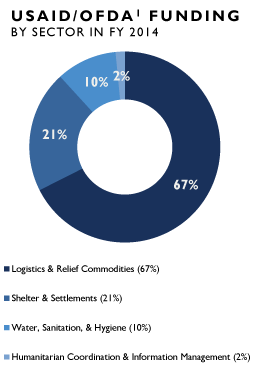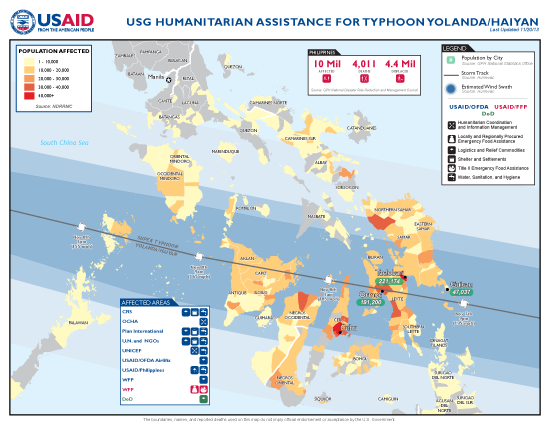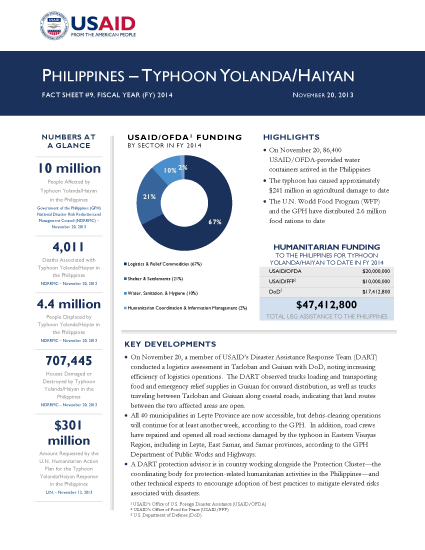- What We Do
- Agriculture and Food Security
- Democracy, Human Rights and Governance
- Economic Growth and Trade
- Education
- Ending Extreme Poverty
- Environment and Global Climate Change
- Gender Equality and Women's Empowerment
- Global Health
- Water and Sanitation
- Working in Crises and Conflict
- Disaster Assistance
- Political Transition Initiatives
- Conflict Mitigation and Prevention
- Countering Violent Extremism
- Disaster Risk Reduction
- Peacebuilding and Reconciliation
- Providing Safe & Secure Environments for Development
- Recovering From Crisis
- Resilience
- Tech Challenge for Atrocity Prevention
- World Humanitarian Day
- U.S. Global Development Lab
November 20, 2013
Numbers At A Glance
10 million
4,011
4.4 million
707,445
$301 million
Humanitarian Funding:
To The Philippines For Typhoon Haiyan/Yolanda To Date In FY2014:

| USAID/OFDA | $20,000,000 |
| USAID/FFP | $10,000,000 |
| DoD | $17,412,800 |
| TOTAL | $47,412,800 |
Typhoon Haiyan / Yolanda Fact Sheet #9 - 11/20/2013 ![]() (pdf - 210k)
(pdf - 210k)
Highlights
On November 20, 86,400 USAID/OFDA-provided water containers arrived in the Philippines
The typhoon has caused approximately $241 million in agricultural damage to date
The U.N. World Food Program (WFP) and the GPH have distributed 2.6 million food rations to date
Key Developments
On November 20, a member of USAID’s Disaster Assistance Response Team (DART) conducted a logistics assessment in Tacloban and Guiuan with DoD, noting increasing efficiency of logistics operations. The DART observed trucks loading and transporting food and emergency relief supplies in Guiuan for onward distribution, as well as trucks traveling between Tacloban and Guiuan along coastal roads, indicating that land routes between the two affected areas are open.
All 40 municipalities in Leyte Province are now accessible, but debris-clearing operations will continue for at least another week, according to the GPH. In addition, road crews have repaired and opened all road sections damaged by the typhoon in Eastern Visayas Region, including in Leyte, East Samar, and Samar provinces, according to the GPH Department of Public Works and Highways.
A DART protection advisor is in country working alongside the Protection Cluster—the coordinating body for protection-related humanitarian activities in the Philippines—and other technical experts to encourage adoption of best practices to mitigate elevated risks associated with disasters.
LOGISTICS AND RELIEF COMMODITIES
- Logistics Cluster partners report that all indicators confirm that surface transport is effective and gaining logistical capacity.
- The U.N. Humanitarian Air Service (UNHAS) has initiated flights from Cebu to serve Roxas, Ormoc, and Guiuan via a fixed-wing aircraft with nine seats. Passenger service on UNHAS flights is free of charge for relief workers at this time. UNHAS is currently unable to use fixed-wing aircraft to access Tacloban due to congestion and a lack of landing slots at the city’s airport. UNHAS plans to position two helicopters in Cebu to begin rotations in coming days.
- Air Asia, Cebu Pacific Air, and Philippine Airlines are operating commercial flights to and from Tacloban. All three carriers will operate one Manila–Tacloban–Manila flight per day and two or three Cebu–Tacloban–Cebu flights per day.
- Logistics Cluster partners, including lead agency WFP, have developed standard operating procedures for sea cargo to streamline loading and reception procedures for humanitarian organizations transporting relief commodities to the Philippines. The standard operating procedures will be used to prevent congestion at ports.
- On November 20, DoD transported 46,200 USAID/OFDA collapsible water containers to Tacloban and Guiuan. In addition, DoD moved 2,400 USAID/OFDA water containers to the MacArthur Park water treatment plant in Tacloban for filling and onward distribution by the GPH Department of Social Welfare and Development (DSWD). An additional 86,400 USAID/OFDA water containers arrived in Manila on November 20, bringing the total number of USAID/OFDA water containers airlifted to the Philippines to 249,400 to date.
- USAID/OFDA continues to support the logistics operations of WFP and several non-governmental organization (NGO) partners. USAID/OFDA has provided nearly $10.3 million to date to support logistics and the provision of emergency relief commodities. In addition, three USAID/OFDA logistics officers are in the Philippines coordinating the arrival and onward distribution of USAID/OFDA-provided relief commodities, conducting logistics assessments, and participating in and supporting the Logistics Cluster.
SHELTER AND SETTLEMENTS
- As of November 20, Typhoon Yolanda/Haiyan had damaged or destroyed more than 707,000 houses, according to the NDRRMC. Nearly 400,000 people are sheltering in 1,521 evacuation centers, while more than 4 million others are displaced outside of evacuation centers.
- In Tacloban, the Astrodome and an elementary school, both serving as evacuation centers, are hosting more than 10,000 people, according to DSWD. The U.N. reports that overcrowding in evacuation centers, particularly in Eastern Visayas Region, where Tacloban is located, affects the health and well-being of affected populations.
- The U.N. reports that shelter materials, including 6,000 corrugated iron sheets for shelter and 2,580 shelter kits, as well as plastic sheeting, have arrived in affected areas over the past several days to address shelter needs.
- USAID/OFDA has airlifted 2,000 rolls of plastic sheeting from its warehouse in Dubai, United Arab Emirates, to the Philippines for onward distribution by partners, benefiting approximately 20,000 families. In addition, USAID/OFDA has provided $3.1 million to Catholic Relief Service (CRS) and Plan International to distribute shelter kits to typhoon-affected households.
AGRICULTURE AND FOOD SECURITY
- As of November 19, the typhoon had damaged or destroyed 153,500 hectares of crops, including rice, corn, cassava, coconut, vegetables, banana, and mango, among others, according to the GPH Department of Agriculture. The U.N. reports that damaged and destroyed crops include ready-to-harvest rice fields and newly planted rice plots. Agricultural damage resulting from the typhoon currently totals $241 million, with an estimated $24.5 million in production losses for the fisheries sector, according to the GPH. The U.N. Office for the Coordination of Humanitarian Affairs (OCHA) estimates that 1 million farmers and fishers require assistance to restore their livelihoods.
- As of November 20, DSWD and WFP had distributed 2.6 million food rations, which include rice provided by USAID/FFP, to typhoon-affected populations. In addition, the International Committee of the Red Cross—through the Philippine Red Cross—and other humanitarian partners have distributed emergency food commodities to nearly 215,000 people in affected areas.
- WFP and DSWD are distributing USAID/FFP-provided emergency food products, which include ready-to-eat paste, rice bars, and wheat bars, to typhoon-affected populations.
INTERNATIONAL ASSISTANCE
- The U.K. Department for International Development (DFID) has chartered an aircraft capable of transporting 110 metric tons (MT) of cargo to help increase capacity at Cebu’s airport. The Antonov-124 is the world’s third heaviest aircraft and is expected to double the capacity of the airport, which handles more than 800 MT of cargo per day.
- As of November 18, international donors had pledged approximately $280 million to address humanitarian needs among populations affected by Typhoon Yolanda/Haiyan. The total amount pledged represents approximately 93 percent of the $301 million requested by the U.N. Humanitarian Action Plan for the Philippines typhoon response.









Comment
Make a general inquiry or suggest an improvement.